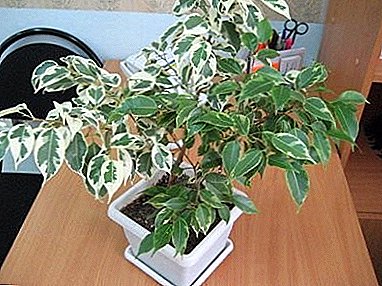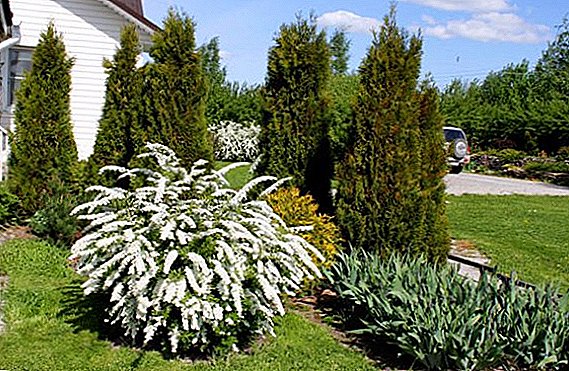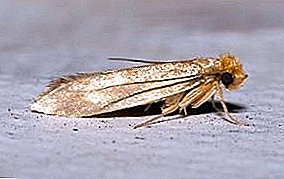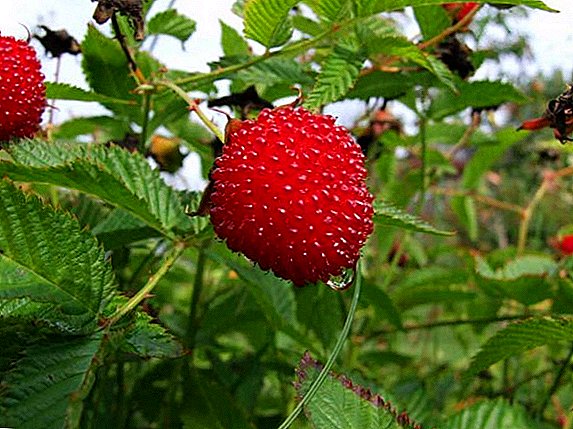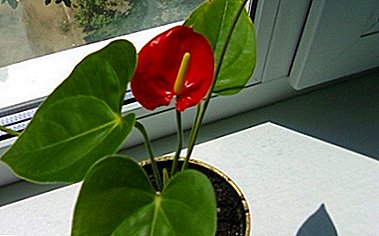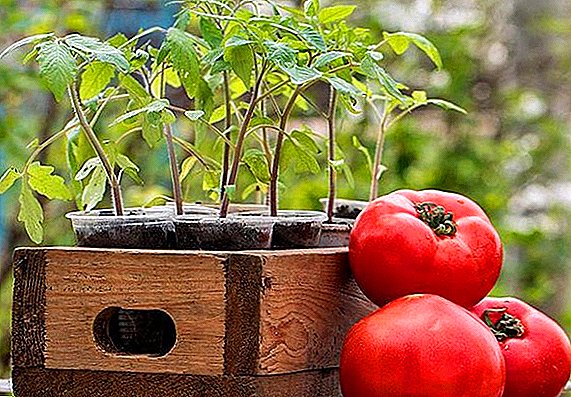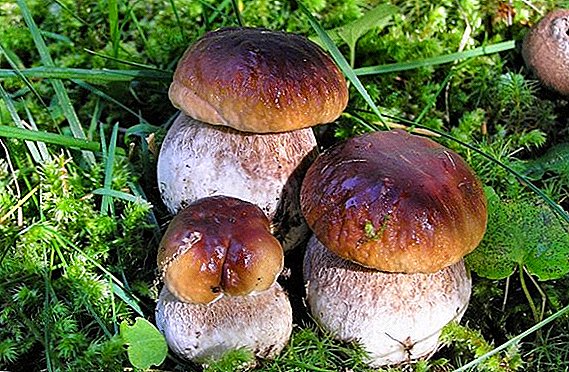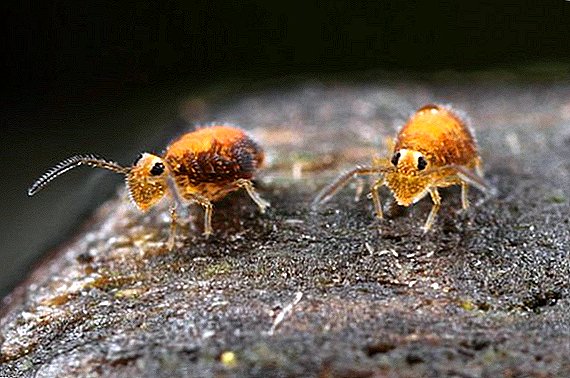 Sometimes when watering indoor plants, feeding fish or visiting the bathroom everyday, the owners of houses and apartments encounter an incomprehensible, often jumping, like a flea, insect. As a rule, such meetings plunge us into shock, there is a thought about the inevitable harm to property, not to mention the natural disgust. Today we will discuss the springtail, the reasons for its appearance and methods of dealing with it.
Sometimes when watering indoor plants, feeding fish or visiting the bathroom everyday, the owners of houses and apartments encounter an incomprehensible, often jumping, like a flea, insect. As a rule, such meetings plunge us into shock, there is a thought about the inevitable harm to property, not to mention the natural disgust. Today we will discuss the springtail, the reasons for its appearance and methods of dealing with it.
What a spring tail looks like: description
The horntail, aka kollembola or podura, belongs to the class of arthropod insects. These are small insects from 1 to 17 mm in size, distributed in almost all climatic zones, where conditions are suitable for them.
Representatives of the class prefer a wet habitat: the shores of reservoirs, including salt, mosses and lichens, tree trunks. Many of them have adapted to slip on the water surface, so they can often be seen on the leaves of aquatic plants. 
You will be useful to read about how to get rid of cockroaches, moths and bedbugs at home on their own.
Some of them are able to bounce, thanks to a special organ under the abdomen, which is called a fork. Collembola differ in body structure and color.
They may have an elongated and spherical shape, whitish, gray, yellowish and brown color, often the body has a metallic sheen, a spotted pattern or stripes. Their diet consists of rotted plants, fungal mycelium, and bacteria that form on organic remains. Often, forming large colonies, insects devour tender parts of higher plants.
Did you know? Negohvostka - one of the oldest inhabitants of the planet. According to research conducted by scientists under the auspices of the National Geographic Society of the United States, these insects lived more than 400 million years ago, when the Earth’s flora was represented only by algae, mosses and fungi.
Causes of
The main reason for the appearance is high humidity, and specifically:
- crevices in window frames;
- leaking tap;
- moisture collecting in the gaps between the tiles;
- poorly processed seams and joints in the fixing points of plumbing;
- formed mold in places with high humidity;
- excessive watering of plants with poor drainage of the pot;
- the use of organic fertilizers for indoor plants (brewing, dairy products, used coffee);
- the foliage which has fallen from house plants;
- water collected in the pot;
- raw soil before planting;
- in the case of an aquarium, delay in cleaning and replacing water;
- food for residents of the aquarium, scattered on the sides;
- rotting aquatic plants.

Important! Moisture is an excellent environment for the fungus and bacteria that make up the diet of springtails. But the cause must be sought not only in the house. It often happens that the store bought soil or plant is already inhabited by insects. Therefore, you need to carefully inspect their purchases, disinfect the soil, and replant the plant in clean soil.
How to recognize: symptoms of infection
Symptoms of infection of houseplants are visible to the naked eye: a white coating on the surface of the ground, microscopic white insects creeping in the same place. Insects are like mealybugs, also resemble a caterpillar with a mustache. The body is about 2 mm long, the color is usually white.
On the leaves, they, in principle, have nothing to do, they find food on the surface of the ground. If you dig deeper, they can be seen on the roots of the plant. With a large accumulation of insects can be observed damage to the leaves, especially those that relate to the soil.
Houseplants are also often affected by the scythe, spider mite, mealybug, whitefly, and nematode.
 Detecting collembolus in an aquarium is also not difficult; it is good enough to inspect the plants inhabiting it, as well as the walls of the tank. Green plaque on the walls is the site of the spread of organic bacteria with which poules love to eat.
Detecting collembolus in an aquarium is also not difficult; it is good enough to inspect the plants inhabiting it, as well as the walls of the tank. Green plaque on the walls is the site of the spread of organic bacteria with which poules love to eat.
Formation of the aquarium is promoted by the aquarium spray system: during its operation, small sprays are retained on the surface of the walls and the container lid.
Quick and nimble, often gray in color, springtails settle in the bathroom. You can find them under the sink sink, in poorly treated joints plumbing, tile slots, at the bottom of the bath, as well as everywhere where water accumulates and in places of formation of mold. 
Harm and consequences
Solitary insects will not harm either indoor plants or aquarian vegetation. But, in the case of active reproduction, a colony of hungry insects can switch to live food. Having stuck to the root system, insects drink juice, injure the stems and leaves of home flowers. Fresh seedlings are particularly affected.
For the reproduction of certain types of collembolles, the participation of both partners in the process is not required. Males lay a seed protected by a transparent sphere. The female fertilizes independently, stumbled upon spermatophores, and in order for the seed to catch her eye, a whole gallery of transparent globs with seminal fluid is planted.
Effective methods of struggle
Insect control takes place in several stages: the identification of their localization, general cleaning, the use of various means that destroy adults and their offspring. 
Mechanical cleaning
The first thing to do is reduce the humidity in the house. In the warm season it is enough to open the windows for fresh air. In wet or cold weather, you can use fans, air conditioners. It is necessary to inspect all possible corners, crevices, places under the pipes, plumbing and dry them. Be sure to remove mold plaque if present.
In order not to use aggressive mildew cleaners for you and your pets, use folk recipes:
- dissolve two spoons of essential tea tree oil in 500 ml of water, apply to the surface with a spray bottle and leave for 12 hours;
- process the desired surface with a mixture of water, vinegar, hydrogen peroxide and boric acid, proportions - 4: 2: 2: 1. Wipe the surface with a cloth soaked in liquid;
- surface can be treated with soapy water. Soap, hitting an insect, "stick" the organs of his breathing and, accordingly, it will die.
They also fight with springtails using tobacco dust, as well as tinctures of onion or garlic.

Potato bait
Ordinary potatoes will help lure the pest out of flower pots. It is necessary to cut it into two parts and lay it down on the surface of the soil. Legs will not miss the opportunity to gather near the power source. Then you need to act quickly: cover the trap with an insect bag and carefully remove, discard potatoes.
Cruciferous flea beetles, May beetles, bears, rapeseed leaf beetles, cabbage, locust, leafworms, tsikadkas, golden eyes, weevils, Colorado beetles, thrips and leaf beetles also bring great harm.
Wood ash
Wood ash, besides fertilizing plants, absorbs excess moisture in the soil. It is scattered over the entire surface of the soil with a layer of 1 cm. In this case, watering is not carried out, and the humidity of the air is brought to normal levels.
Important! Colors like butzaliya, alokaziya, hydrangea, dieffenbachia, camellia such treatment can be harmful. For flowers that prefer acidic and slightly acidic soil, it is better to use mustard powder.

Chemicals
Insecticides are used mainly on plants, but you can spray the places where you saw collembol:
- "Aktara" - 0.1 g of the substance is dissolved in a liter of water, the product is applied both on the soil in the pot and on the leaves of the plant. The action is long - up to six weeks;
- "Basudin extra" - the contents of the ampoule (half) are dissolved in water at room temperature (4 l) and sprayed with a spray. The effect of the drug appears after a few hours;
- "Regent" - a vial of the drug is diluted in a liter of water and sprayed the places where the pests were detected, as well as the soil of flower plants.
You can also use insecticide concentrates for dilution and subsequent spraying from spray guns, for example, Lambda Zone, Delta Zone, Get, or aerosols adapted for use against insect pests in flat conditions: Clean House, Kombat , "Raptor", "Armol" - they can also be used against springtails. 
Important! If there are animals in the apartment, carefully read the instructions for the drug used, it can be safe for you, but toxic to your pet.
Protection and preventive measures
Prevention from the appearance of insects will save both time and money that will go to eliminate the consequences after their invasion.
For bathroom
Wooden window frames (if available) are preferably impregnated with a waterproof substance. If there are leaking taps or pipes, mixers - the problem needs to be fixed. Treat all kinds of joints and gaps with sealant, especially the joints of the sides of the bathroom and shower.
To maintain a normal level of humidity in the bathroom, you can install an electric towel dryer. Then the condensate on the walls and other surfaces will evaporate faster, and for the fungus, including mold, there will be no chance.  During the cleaning of an apartment or house, the bathroom should be given special attention: to wipe dry residues of moisture and wet surfaces, from time to time with cleaning agents, especially the seams of tiles and the same plumbing joints.
During the cleaning of an apartment or house, the bathroom should be given special attention: to wipe dry residues of moisture and wet surfaces, from time to time with cleaning agents, especially the seams of tiles and the same plumbing joints.
For aquarium
The source of bacteria that attracts suck, are microorganisms that appear in stagnant water, rotting plants. Therefore, the aquarium needs regular replacement of water, general cleaning: washing the tank, decorative elements, water plants under running water, washing the soil.
Carefully flush out the filters and aeration systems that are in the aquarium. When feeding fish and other aquatic creatures, make sure that no residual food remains on the sides of the tank. 
For home plants
The basic rule of the absence of insects in the pots of flowerpots - compliance with agricultural engineering:
- good drainage so that the moisture does not stagnate;
- extremely rare use of organic fertilizers;
- soil calcination or manganese disinfection;
- moderate watering;
- timely removal of fallen leaves and inflorescences;
- normal moisture;
- pot volume corresponding to the size of the root system;
- compulsory loosening of the soil after watering - it will saturate it with oxygen, the desired flower, and will not allow moisture to linger for a long time.
In conclusion: getting rid of the springtail is not as difficult as it may seem, and you can cope with this problem without the use of chemicals if you get down to business on time.
If you look, then insects bring harm only to the plant, and then - due to our own negligence, for the rest, their proximity, in addition to hostility to the class of arthropods, does not. Keep your house clean, air the living quarters - and there’s no reason for your spring tail to show up.


